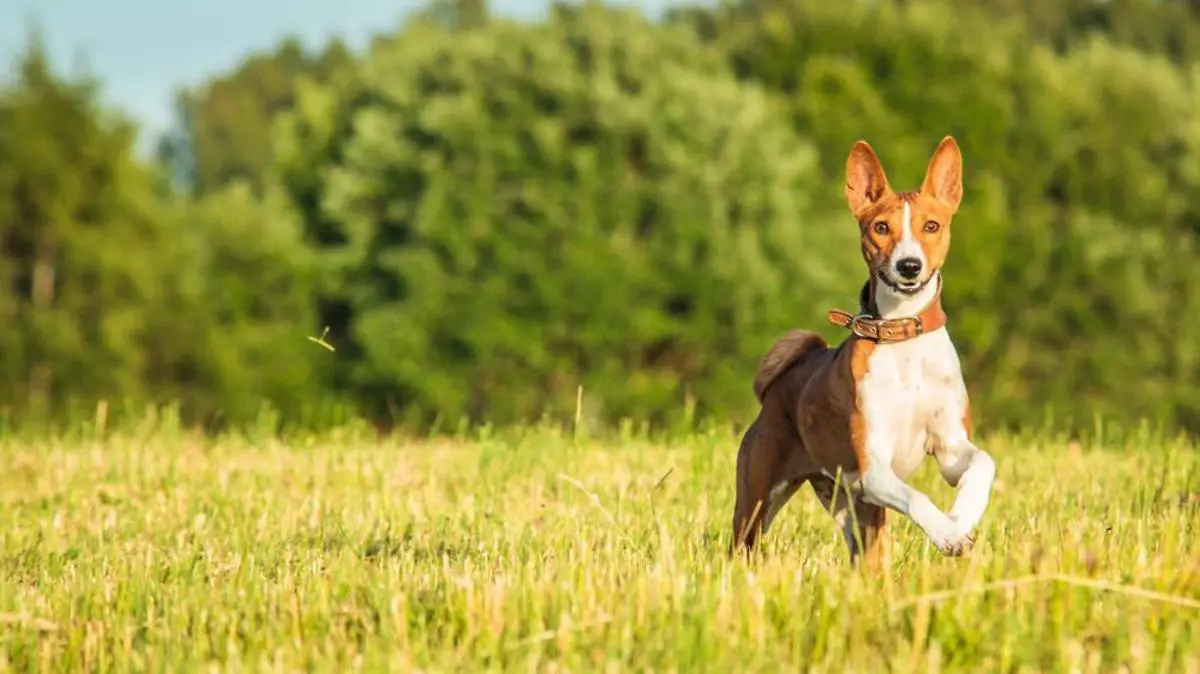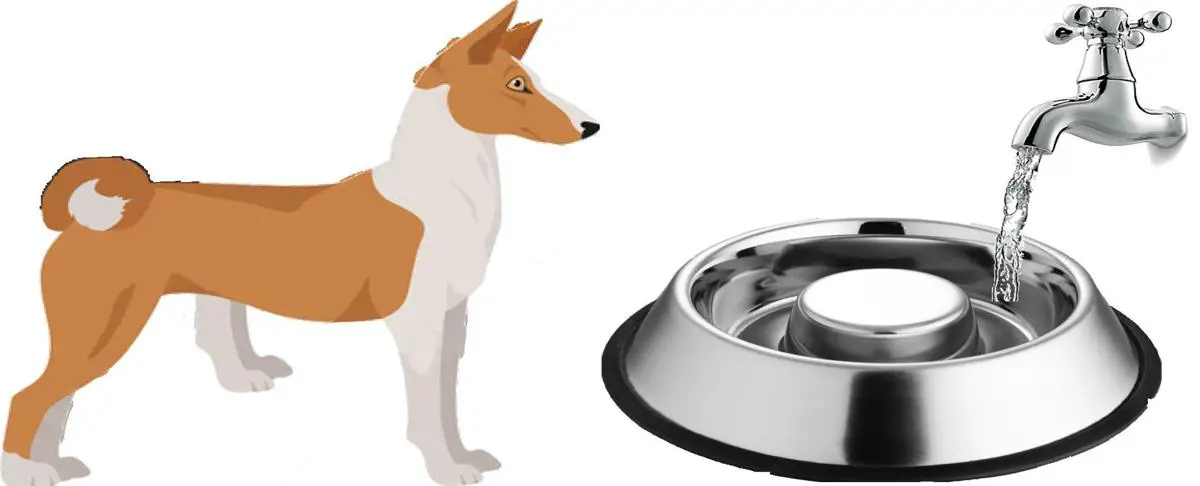Quick Links: Table of Contents
- Basenji Breed Overview
- History of the Basenji Breed. Where Basenjis came from
- What the Basenji Looks Like
- How Much is the Basenji Puppy?
- Best Basenji Breeders
- Basenji Growth
- The Temperament of the Basenji
- Basenji Litter Size
- How Fast Basenjis Can Run
- Good Names for Basenjis
- How Intelligent are Basenjis?
- How Popular are Basenjis with New Dog Owners?
- Health Problems in Basenjis and How to Prevent Them
- How to Take Care of Basenji
- Dog Breeds That Are Similar to Basenjis
- Other Things to Know About Basenjis
Basenji Breed Overview
The Basenji is a small-sized dog.
The adult Basenji stands 16 to 17 inches tall at the shoulder.
The Basenji belongs to the Hound Dogs group.
Dogs in the Hound Dogs group, like the Basenji, were bred to pursue and hunt warm-blooded animals. Hounds hunt by using their good sight or their good sense of smell. Dogs that belong to the Hound Group have strong prey drives and often will stop at nothing to catch what they are pursuing.
The fact that the Basenji belongs to the Hound Dogs group is one of the reasons why Basenjis have the personality and temperament that they have.
The temperament of the Basenji is generally described as:
- Affectionate
- Alert
- Confident
- Curious
- Energetic
- Intelligent
- Playful
- Quiet
History of the Basenji Breed. Where Basenjis came from
Although the breed`s exact history is uncertain, the dog`s forebears are thought to have come from Central Africa.
The word “Basenji,” which means “bush thing,” derives from ancient Congo and Sudanese dogs and is the origin of the breed`s name.
It is also claimed that because of their prominence as companions, the pharaohs received gifts of this cherished dog.
Although there are images of canines like this one in ancient Egypt, it is difficult to say whether the barkless puppy was the breed represented.
This enthusiastic puppy was first brought to England in the 1930s after earlier attempts in 1895 failed due to disease in the dogs.
In the past, these elegant and alluring dogs have appeared in films like Goodbye, My Lady from 1956.
The dog is given more attention in the film because of its distinctive yodel rather than its usual bark.
In the 1980s, more dogs were brought into the country from Africa to broaden the gene pool and aid in breeding out inherited issues.
Additionally, there was an effort to add new hues to the breed, such as brindle.
Around this time, the short-haired puppy began participating in trials and was formally recognized as a sighthound.
Regarding formal breed recognition, the Basenji Club of America was established in 1942, and they were officially recognized as a breed in 1943.
.
What the Basenji Looks Like
The Basenji is described as having a light frame and a quick pace.
They also have high legs that look proportionally longer than their torsos.
They are described as having small, almond-shaped eyes ranging in color from dark hazel to dark brown, and a nose shorter than the skull.
They can hunt more effectively because their spiky ears are fixed to the top of their heads.
Their short, straight coat can be any of the following colors: brindle and white; black and white; red and white; tricolor (black, tan, and white); or trindle color (black, brindle, and white).
This charming dog keeps its white tail tip, white belly, and white paws.
Over their back, the tail coils.
.
How Much is the Basenji Puppy?

The average price of a Basenji puppy is $1560. The price of a Basenji puppy ranges from $1450 to $1450.
A lot of factors determine the price of the Basenji. These factors include what health records the Basenji puppy has, the lineage of the Basenji puppy, the US state the breeder is located in, etc.
To estimate how much you can expect to pay for a puppy Basenji based on the many factors that determine the price of the Basenji puppy, check out our calculator that lets you estimate how much you should expect to pay for the Basenji puppy based on what you want in the puppy.
When looking to buy a puppy, look at buying a puppy only from well-established breeders that breed puppies primarily for the love of the Basenji breed, and secondarily for profit. Do not buy a puppy from a puppy mill. Puppy mills mass-produce puppies in bad living conditions for maximum profit.
You may also consider adopting instead of buying a puppy. Adoption costs are very low compared to the price of a puppy.
Best Basenji Breeders
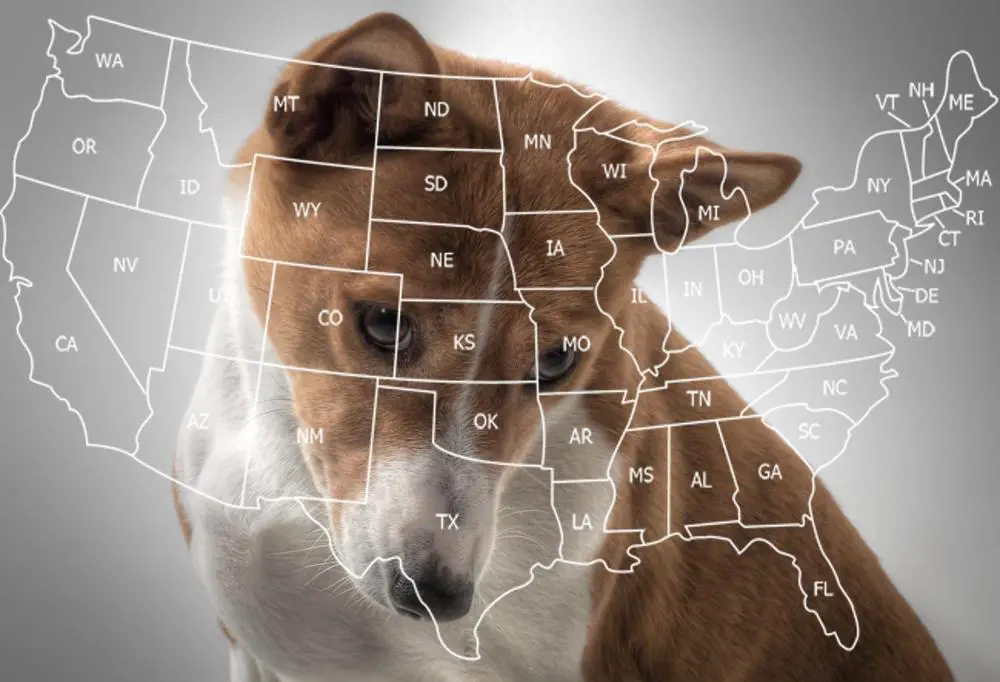
We have researched reputable Basenji breeders that you can buy a puppy.
Go to this page for our complete list of reputable Basenji breeders in various states in the United States.
On this page, you will see how much these breeders sell their puppies for, and how many puppies they have available.
A few of these breeders are listed below.
Sandra Cyrus
Puppy Price: Check with breeder
Candi Becker
Puppy Price: $1800
Carolene Rose
Puppy Price: Check with breeder
IRINA RASKOPINA
Puppy Price: Check with breeder
Kerry Carman
Puppy Price: Check with breeder
Basenji Growth
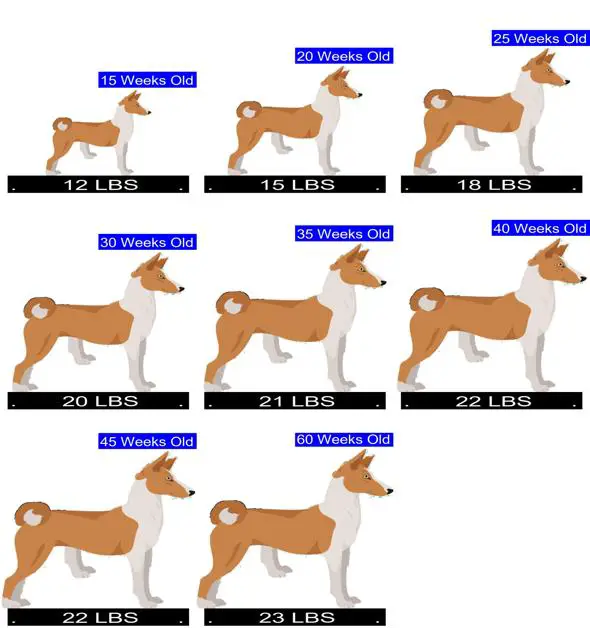
New Basenji owners need to know about the growth of their Basenjis. This will help them plan their living spaces accordingly.
Also, knowing the typical growth pattern of the Basenji will help new owners catch the abnormal growth of their Basenji early.
See our calculator for predicting how big your Basenji puppy will get. You will also learn about the typical weight of the Basenji at different ages and how to catch abnormal growth in your Basenji
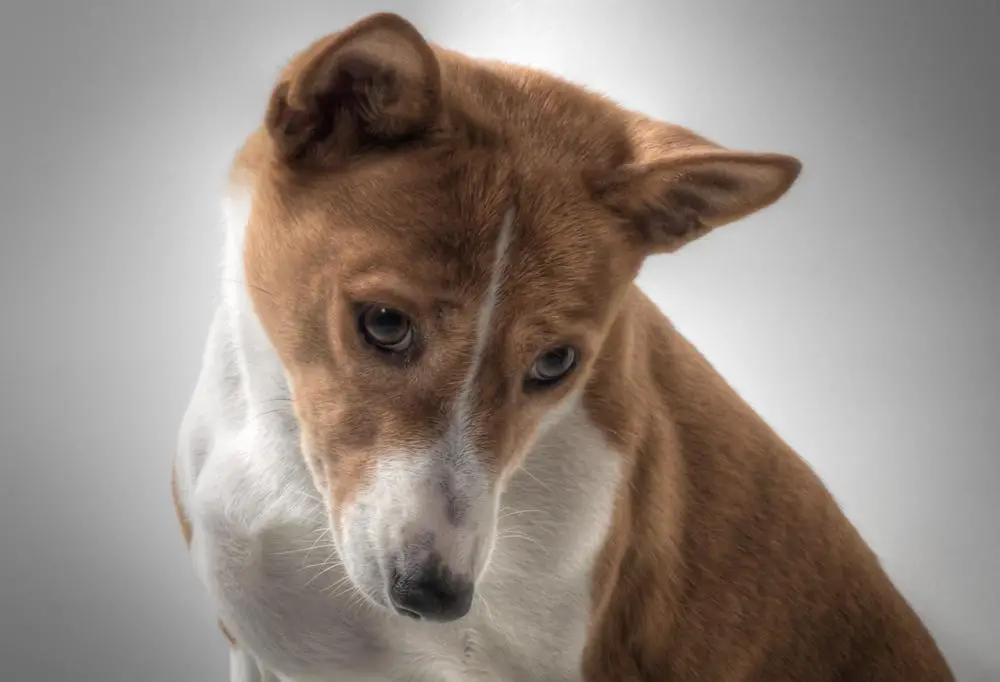

The Temperament of the Basenji
The temperament of the Basenji based can be summarized as in the table below.
The table shows the scores of the Basenji for 13 important dog behavioral factors.
We obtained these scores by analyzing raw data from the C-BARQ dog personality survey tool. The higher the score of a dog for a factor, the worse the temperament of the dog regarding that factor.
The C-BARQ tool was developed by researchers from the University of Pennsylvania, and it is a scientific tool that is used worldwide for reliably measuring the temperament of dog breeds.
See our complete analysis of the temperament of the Basenji here.
| Factor | Score |
|---|---|
| Owner Directed Aggression | 84.3 percent |
| Stubbornness | 82.9 percent |
| Dog Rivalry | 79.7 percent |
| Dog Directed Fear | 76.5 percent |
| Dog Directed Aggression | 66.6 percent |
| Separation Related Behavior | 63.8 percent |
| Stranger Directed Fear | 61.1 percent |
| Attachment Attention Seeking | 54.7 percent |
| Nonsocial Fear | 46.0 percent |
| Touch Sensitivity | 35.3 percent |
| Energy Level | 32.4 percent |
| Excitability | 31.3 percent |
| Stranger Directed Aggression | 29.9 percent |
| Prey Drive | 100.0 percent |

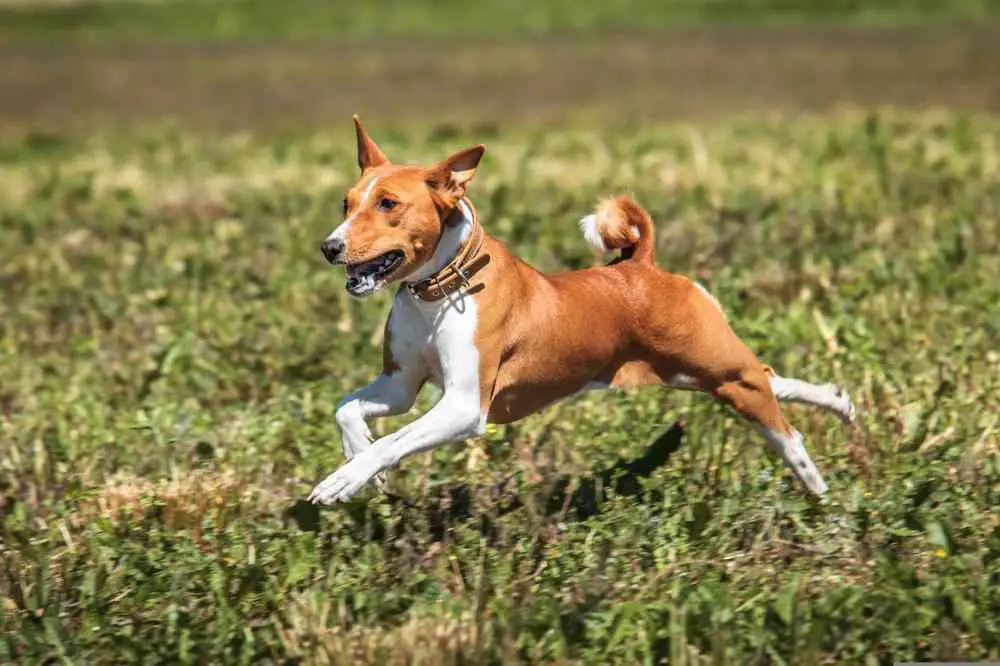
Basenji Litter Size
Researchers from the Norwegian School of Veterinary Science did a study where they counted the numbers of puppies in 22 different Basenji birth litters.
From this study, the researchers found that the average number of puppies that Basenjis can have is 4 puppies. Also, the Basenji can have as few as 1 puppies per litter and as many as 8 puppies per litter.
The number of puppies that the Basenji will have depends on factors such as the age of the Basenji, the method of pregnancy, etc.
Click here to see our calculator for predicting how many puppies your Basenji will have and how the litter size of the Basenji compares to the litter size of other dog breeds.
How Fast Basenjis Can Run
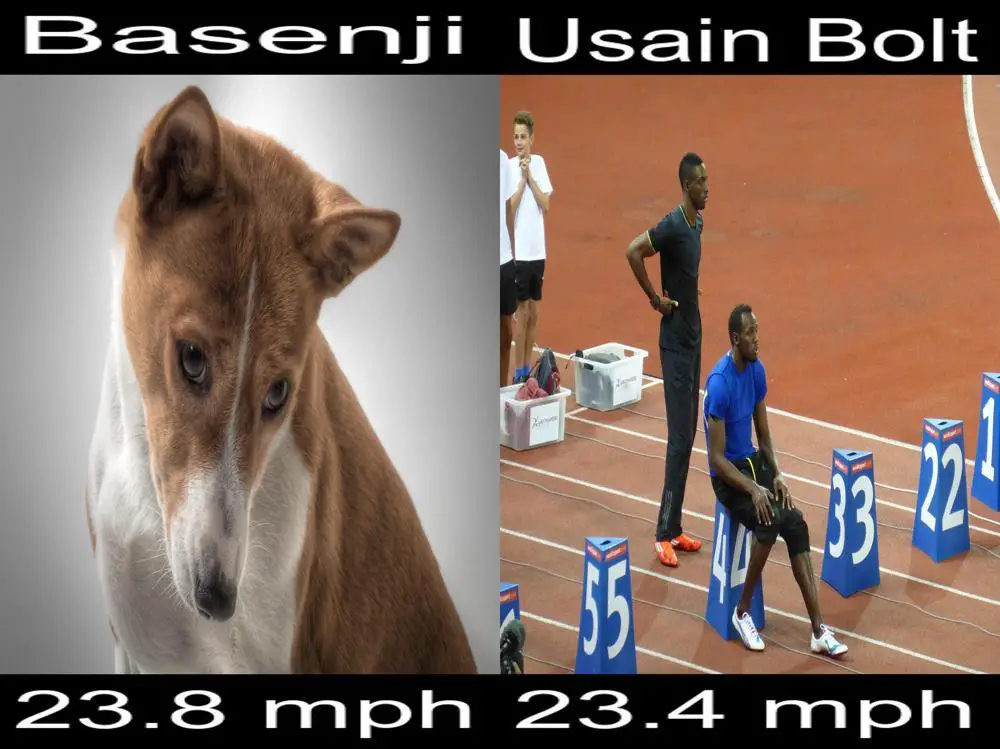
How fast a dog breed can run is a good measure of how athletic the dog breed is.
The American Kennel Club (AKC) regularly conducts dog running competitions. The AKC records the running speed of competing dogs in these competitions. These competitions are open to all dog breeds.
Based on our analysis of the speeds of 249 different Basenjis, the average speed of the Basenji is 23.8 mph (38.3 kmph).
The fastest speed on AKC record that the Basenji ran in a race is 30.83 mph (49.6 kmph) and the minimum speed on record in a race for a Basenji is 8.49 mph (13.7 kmph).
Click here to see how the speed of the Basenji compares to the speed of other dogs and other mammals such as cats, horses, humans, etc.
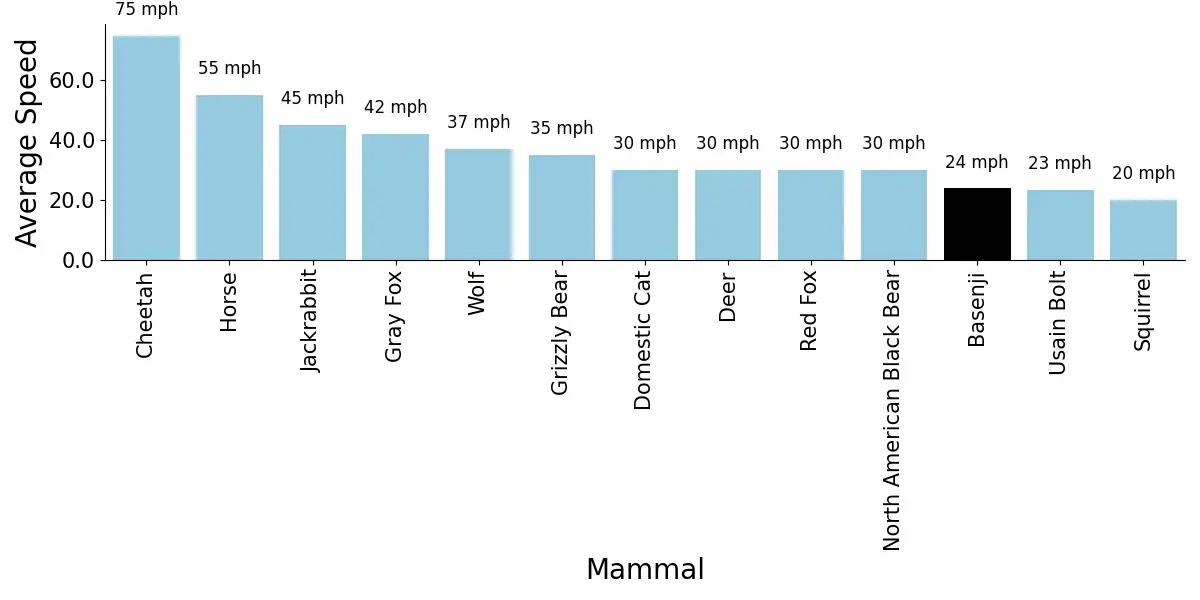
Good Names for Basenjis
Here are some really good names that are typical for the Basenji ranked by popularity:
- Rodney
- Chance
- Milo
- Link
- Spaghettio
- Clay
- Khufu
- Puff
- Max
- Marty
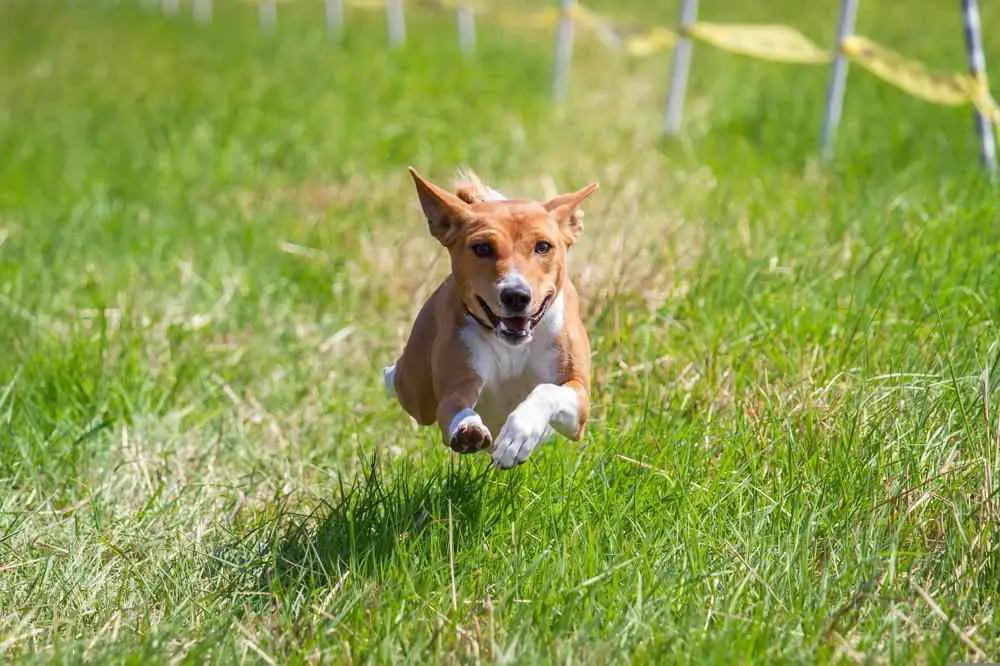
How Intelligent are Basenjis?
| Basenji | |
|---|---|
| Intelligence Rank | 78 out of 130 dog breeds |
| Trainability | Tend To Learn New Commands After 80 To 100 Repetitions Or More! |
According to Prof. Stanley Coren, a Canadian psychology professor/dog trainer, the total intelligence that a dog demonstrates is the addition of three types of intelligence. These intelligence types are:
- Instinctive Intelligence: This is the natural intelligence that comes from instinct. For example, dog breeds that have been historically bred to be guard dogs will have a high `guarding` intelligence compared to dogs that were not bred for guarding.
- Adaptive Intelligence (learning and problem-solving ability): This indicates what a dog can learn to do for himself or herself. Adaptive intelligence is specific to each dog, and not breed specific. You can improve your dog`s adaptive intelligence by investing time to train your dog.
- Working/Obedience Intelligence: This type of intelligence is breed-specific. Certain dog breeds tend to have higher working/obedience intelligence than some other breeds. This intelligence is the closest to what we might call school-learning ability and it is based upon what the dog can learn to do when instructed by humans. This type of intelligence can be measured for each dog breed and compared to that of other dog breeds.
Professor Stanley Coren measured and ranked the working intelligence of about 130 different dog breeds.
Prof. Coren found that the Basenji has an obedience intelligence rank of 78 out of 130 dog breeds. Thus, Prof. Coren put Basenjis in the `Lowest Degree of Working/Obedience Intelligence Dogs` category.
This means that Basenjis tend to learn new commands after 80 to 100 repetitions or more!.
However, we should mention that a dog should not be judged based on its intelligence alone. There are other important factors you need to consider when deciding on which dog breed to get. These other factors include sociability, adorability, and compatibility of the dog breed with your lifestyle.
See the intelligence ranking of some other dog breeds below:
| Breed | Intelligence Rank |
|---|---|
| Papillon | 8 |
| Australian Cattle Dog | 10 |
| Miniature Schnauzer | 12 |
| Belgian Tervuren | 14 |
| English Cocker Spaniel | 18 |
| Airedale Terrier | 29 |
| Border Terrier | 30 |
| Samoyed | 33 |
| Finnish Spitz | 43 |
| Dachshund | 49 |
| Chinese Shar-Pei | 51 |
| Akita | 54 |
| Maltese | 59 |
| Great Pyrenees | 64 |
| Basset Hound | 71 |
| Bloodhound | 74 |
| Chow Chow | 76 |
| American Bulldog | 77 |
| Basenji | 78 |
| Afghan Hound | 79 |

How Popular are Basenjis with New Dog Owners?
Every year, the American Kennel Club (AKC) publishes information on how popular a dog breed is in that particular year. The AKC gets the popularity information of a breed from how many dogs of that breed the owners register with the AKC every year. The AKC collects this data for about 200 dog breeds.
The graph below shows the popularity trend of the Basenji.
The popularity of the Basenji averaged over the years is Number 86 out of about 200 dog breeds.
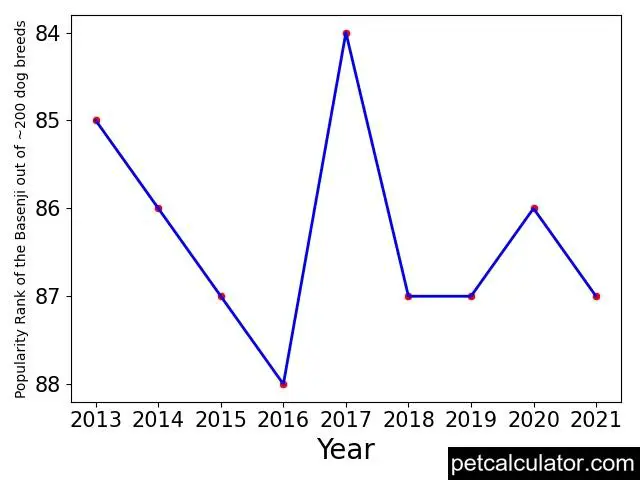
Do not get a dog breed just because it is a popular dog breed. And do not reject a dog breed just because it is an unpopular breed.
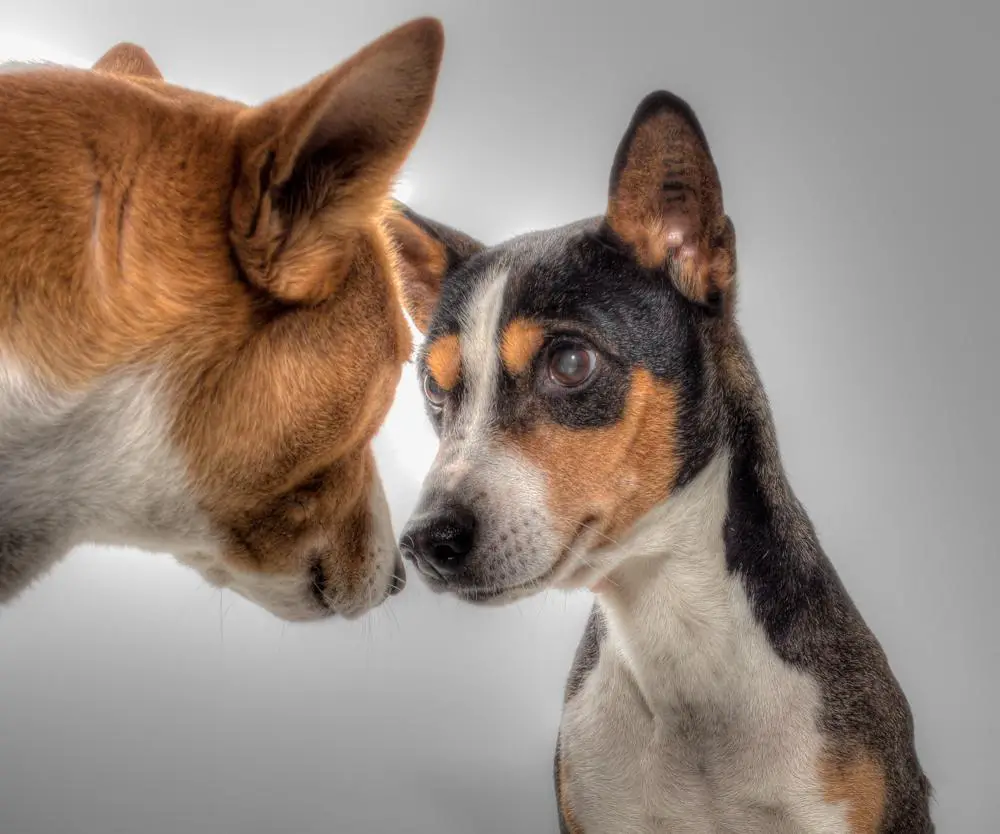
Health Problems in Basenjis and How to Prevent Them
Every dog breed has its own set of health problems that it tends to develop. There is nothing like a perfect dog breed.
The Basenji is prone to certain genetic health conditions. The Orthopedic Foundation for Animals (OFA) is an organization that keeps track of genetic health problems in dog breeds.
From the extensive records that the OFA keeps, the OFA knows what health problems each dog breed is naturally prone to develop.
Hence, the OFA recommends which health screening breeders should perform on a dog breed to make sure that the breeders won`t breed `defective` dog parents that can pass down defective genes to their puppy offspring.
If you want a Basenji puppy that will grow up to be healthy, make sure that your Basenji breeder screens your puppy or your puppy`s parents for the health problems that the OFA recommends for your puppy`s breed. This will increase the chances that your puppy is free from genetic defects.
The following are the health tests that Orthopedic Foundation for Animals (OFA) recommends that breeders should screen Basenjis for:
- Autoimmune thyroiditis
- Basenji Night Blindness / PRA DNA Test
- Eye Examination each year until 6, thereafter every 2 years
- Fanconi syndrome
- Hip Dysplasia
- OFA/U of Missouri
You can find out more about OFA`s recommended tests for Basenjis here.
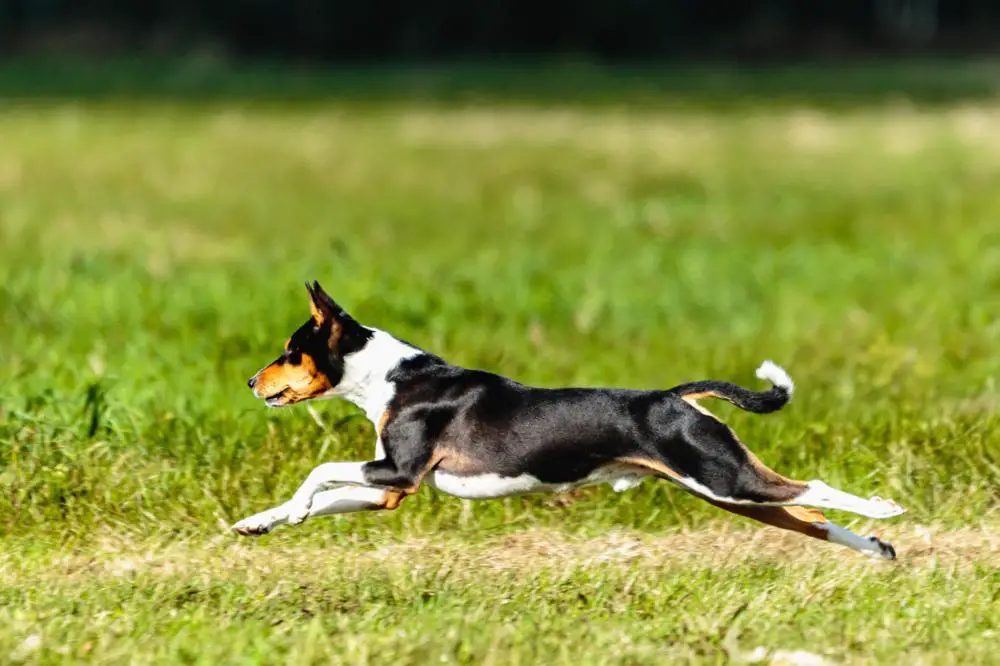
How to Take Care of Basenji
To take good care of your Basenji, you need to make sure that you groom your Basenji regularly.
Secondly, you need to find a veterinarian in your area that will routinely check the health status of your Basenji regularly, and give you appropriate recommendations on your Basenji`s preventative care.
Thirdly, you need to commit some time to exercise your Basenji daily. Regular exercise helps improve the health and quality of life of your Basenji.
Also, you need to feed your Basenji high-quality dog food, and the food should be of the right amount to prevent your Basenji from getting overweight or underweight.
See our recommendations on what to feed the Basenji and how much food to feed the Basenji at different life stages.
Finally, you need to make sure that your Basenji has access to clean water all the time. See our recommendations on how much water your Basenji needs to drink at different ages.
Dog Breeds That Are Similar to Basenjis
If you have not made up your mind on which dog breed to get, you may also want to consider some other dogs similar to the Basenji.
We crunched the numbers and found that the following dog breeds that have similar behavior and temperament as the Basenji:
- Ibizan Hound (68 percent match with Basenji). Learn more about the Ibizan Hound here.
- Italian Greyhound (69 percent match with Basenji). Learn more about the Italian Greyhound here.
- Sloughi (68 percent match with Basenji). Learn more about the Sloughi here.
- Whippet (69 percent match with Basenji). Learn more about the Whippet here.
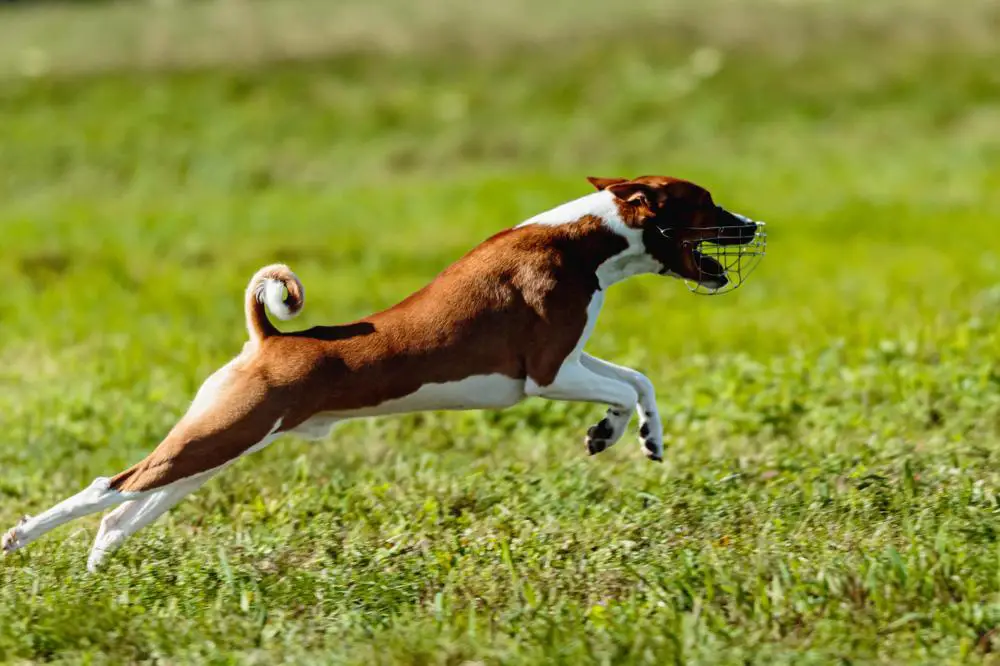
Other Things to Know About Basenjis
Here are some of the very important characteristics of the Basenji that you need to know about the Basenji breed:
